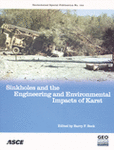Combining Surface and Downhole Geophysical Methods to Identify Karst Conditions in North-Central Iowa
Publication: Sinkholes and the Engineering and Environmental Impacts of Karst
Abstract
Karst conditions in the glaciated terrain of north-central Iowa are often difficult to ascertain during typical site reconnaissance. Surface and downhole geophysical techniques are useful to better characterize karst features where they are hidden by a generally featureless topography. An iterative investigative strategy, involving high-resolution surface geophysical techniques, complemented with downhole geophysical logging and rock coring, proved effective in providing sufficient information to adequately characterize bedrock conditions in this difficult setting. An 800-acre site in north-central Iowa was one of several proposed for a coal-fired electric generating facility. Concerns arose over the possibility of karst conditions at the site that could impact facility design and construction. Although several shallow closed topographic lows, described as sinkholes by soil scientists, were mapped on the property, no subsurface investigations had been conducted in the vicinity to document bedrock quality or karst development. An investigation using high-resolution surface geophysical techniques to focus an exploratory drilling program was proposed. The boring program was coupled with downhole geophysics to document the bedrock quality and establish better stratigraphic control and to determine the structural character of the shallow bedrock. Surface geophysical techniques included micro-topography using a differential global positioning system (DGPS) to produce a digital terrain model (DTM) that would identify and locate topographical expressions to a resolution of less than 0.5 foot. A high-resolution electromagnetic (EM) conductivity survey was conducted simultaneously in an attempt to identify areas of higher moisture content that may indicate areas of incipient karst development. The results of these surveys were used to identify anomalies that were then surveyed using ground penetrating radar (GPR) to provide three-dimensional imaging and identify specific features to drill. Finally, a shallow seismic survey that utilized Multichannel Analysis of Surface Waves (MASW) was conducted after drilling to provide better definition of shallow solutional features and to compare this emerging technology with the other methods. Two candidate geophysical anomalies were core-drilled to depths ranging from 50 to 150 ft with particular attention applied to identification of subsurface voids. Boreholes were then investigated using downhole video, caliper, natural gamma, resistivity, and spontaneous potential geophysical logging. The caliper was used to identify the locations of bedrock cavities. The natural gamma was used to identify shale aquitards that may affect the distribution of solutional activity and also serve as stratigraphic marker horizons. Downhole video provided indications of groundwater pathways and verified fabric geometry of the fractures and solutional features. Results of the investigation suggest that the DTM and EM were effective for rapid identification of bedrock surface anomalies and soil compositional anomalies over a large area that served to focus the more expensive invasive tools. As a result of signal loss from fine-grained and relatively higher moisture content soils, these techniques could not identify the location of deeper bedrock voids. GPR penetration was limited in areas of clayey till. However, the GPR successfully detected soil surface anomalies where subsequent drilling discovered silt-filled grikes. MASW identified the of the bedrock surface, and was successful in verifying a previously identified filled grike. In summary, this study illustrates that coupling area-wide surface geophysics with a limited boring program can adequately define the bedrock character across large areas where topographic clues are lacking.
Get full access to this chapter
View all available purchase options and get full access to this chapter.
Information & Authors
Information
Published In
Copyright
© 2005 American Society of Civil Engineers.
History
Published online: Apr 26, 2012
Authors
Metrics & Citations
Metrics
Citations
Download citation
If you have the appropriate software installed, you can download article citation data to the citation manager of your choice. Simply select your manager software from the list below and click Download.
